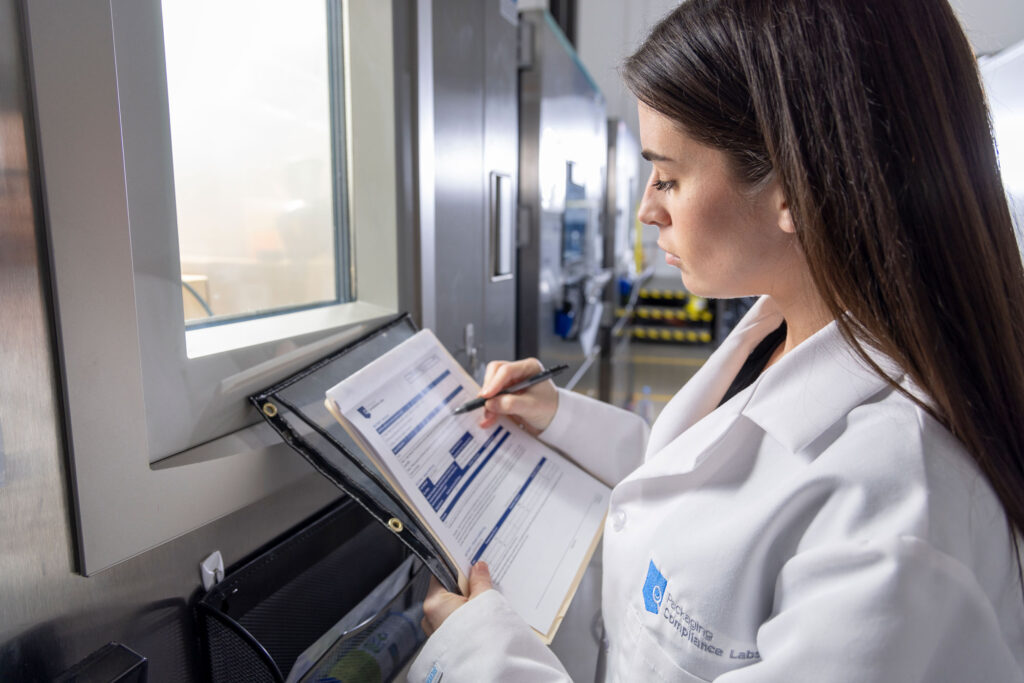

Have you ever wondered how medical devices are sterilized to ensure they are free from harmful microorganisms before reaching patients? If you’re new to the world of packaging, this article will guide you through the fascinating process of sterilization. Sterilization is a critical process in the medical device industry, and while there are several methods available, Gamma and Ethylene Oxide (EO) sterilization are the most widely used due to their effectiveness and compatibility with various materials. We sat down with one of Packaging Compliance Labs’ Packaging Engineers, Alec Respecki, to discuss these sterilization methods in detail.
Gamma Sterilization
Gamma sterilization uses high-energy photons emitted from the decay of cobalt-60. These photons penetrate the device and disrupt the cellular structure of microorganisms, preventing them from reproducing. This method is highly effective and compatible with a wide range of packaging materials, including film, foil, and Tyvek, however, this method does not require a porous component. One of the main advantages of Gamma sterilization is its speed; the process can be completed in a matter of days, making it ideal for high-throughput environments.
However, Gamma sterilization is not without its drawbacks.
- Aesthetics: The high-energy photons can cause significant “cooking” and discoloration of packaging materials or plastic components, which could lead to brittleness, and delamination.
- Seal Strength: The Gamma irradiation process can increase seal strength values due to chemical changes in adhesives, potentially complicating the aseptic opening of sterile barrier systems.
- Incompatible with electronic systems: Another important consideration is that Gamma sterilization is not suitable for electronic medical devices containing batteries or circuit boards, as the radiation can cause these components to explode or catch fire.
- Required Dose Audits: Regular quarterly dose audits are required to ensure the sterilization cycle remains effective, involving sterility testing and bioburden evaluation.
Ethylene Oxide (EO) Sterilization
EO sterilization involves exposing medical devices to ethylene oxide gas, a toxic and highly flammable substance. The gas denatures the proteins of microorganisms, effectively killing them. This method is particularly suitable for electronic medical devices, as it does not damage sensitive components. EO sterilization requires a porous component for your sterile packaging, such as Tyvek™, to allow the gas to penetrate the sterile barrier system and contact the device. The process involves repeated cycles of pressure and vacuum, followed by an off-gassing period to remove any residual gas.
While EO sterilization is effective for complex and expensive medical devices, it has a longer processing time compared to Gamma sterilization. The packaging must be robust enough to withstand high pressure, vacuum, and moisture. Additionally, there is a risk of EO residuals being absorbed by the materials, necessitating an off-gassing period to ensure safety. Routine monitoring with biological indicators is required to verify the effectiveness of the sterilization process.
Choosing the Right Method
Selecting the appropriate sterilization method depends on several factors, including the device’s material, composition, and sensitivity to moisture and light. Medical device manufacturers must consider these factors to determine the most suitable method. For instance, devices with electronic components may benefit from EO sterilization, while those made from materials that can withstand high-energy photons may be better suited for Gamma sterilization.
Regardless of the method chosen, it is essential to demonstrate that the sterilization process meets the required Sterilization Assurance Level (SAL), typically 10^-6 for most medical devices. This means there is a one in a million chance that a device remains non-sterile after the process. Lower-risk medical devices, such as surgical drapes and gowns, may permit a higher SAL of 10^-3.
Conclusion
Understanding the nuances of different sterilization methods is crucial for ensuring the safety and effectiveness of medical devices. Gamma and EO sterilization are the most common methods, each with its own set of advantages and challenges. By carefully considering the material, composition, and specific requirements of their devices, manufacturers can choose the most appropriate sterilization method to ensure their products are safe for use.
Do you need help determining which sterilization method will be best for your device and packaging? Reach out to PCL to be connected with one of our expert packaging team members today!